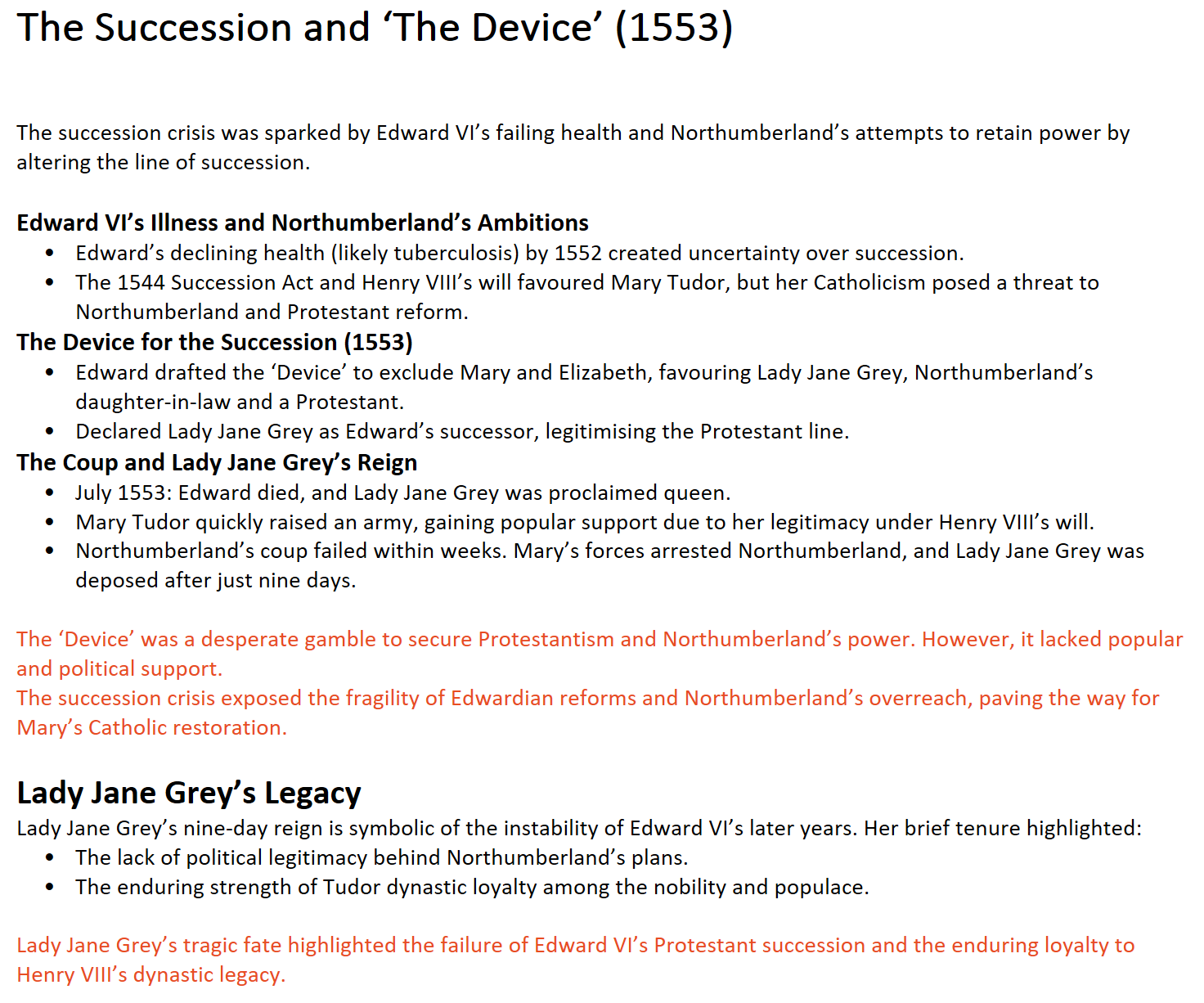Edward VI
Edward VI's Reign: Overview
Age and Character:
Became king at age 9 in 1547, making him highly dependent on advisors.
Judgment: The early age of his accession left Edward vulnerable to the competing ambitions of the Regency Council, which ultimately destabilized the regime during critical periods.
Known for his intellectual abilities and deep commitment to Protestantism, shaped by his education under reformist tutors like John Cheke.
Despite his youth, Edward's strong Protestant ideology influenced government policy, demonstrating his potential as a monarch had he lived longer.
Regency Council:
Initially dominated by Edward Seymour (Duke of Somerset), who styled himself as Lord Protector.
Somerset’s policies aimed at both religious reform and social justice but alienated powerful interests, leading to his fall in 1549.
Succeeded by John Dudley (Duke of Northumberland), who prioritized political and financial stability over social reform.
The shift from Somerset to Northumberland reveals the volatility of Edward's government, with Somerset’s idealistic approach failing where Northumberland’s pragmatism succeeded.
Religious Reforms:
Major Protestant reforms included the introduction of the Book of Common Prayer in 1549 (moderate) and its revision in 1552 (more radical).
Shifted England further from Catholicism by abolishing mass, promoting English liturgy, and destroying religious images.
While these reforms entrenched Protestantism, they alienated large sections of the population, particularly in conservative regions, sowing seeds of rebellion.
Economic Issues:
Widespread inflation due to the debasement of coinage, initiated under Henry VIII, continued under Edward VI.
Enclosures led to rural discontent as land previously held in common was privatized.
Taxation, particularly the sheep tax of 1548, worsened conditions for subsistence farmers.
Economic pressures were arguably a greater source of instability than religious reforms, as they affected both Protestant and Catholic subjects alike.
Foreign Policy
Under Somerset:
Focused on securing a marriage alliance between Edward VI and Mary, Queen of Scots to unite England and Scotland.
Victory at the Battle of Pinkie (1547) strengthened England’s position, but Scotland allied with France, rendering English efforts ineffective.
Somerset’s failure to achieve long-term success in Scotland drained financial resources and distracted from domestic unrest.
Under Northumberland:
Ended costly wars by withdrawing from Scotland and surrendering Boulogne to France in 1550, securing peace.
Northumberland’s pragmatic approach freed resources to address domestic issues, marking a turning point in Edward's reign.
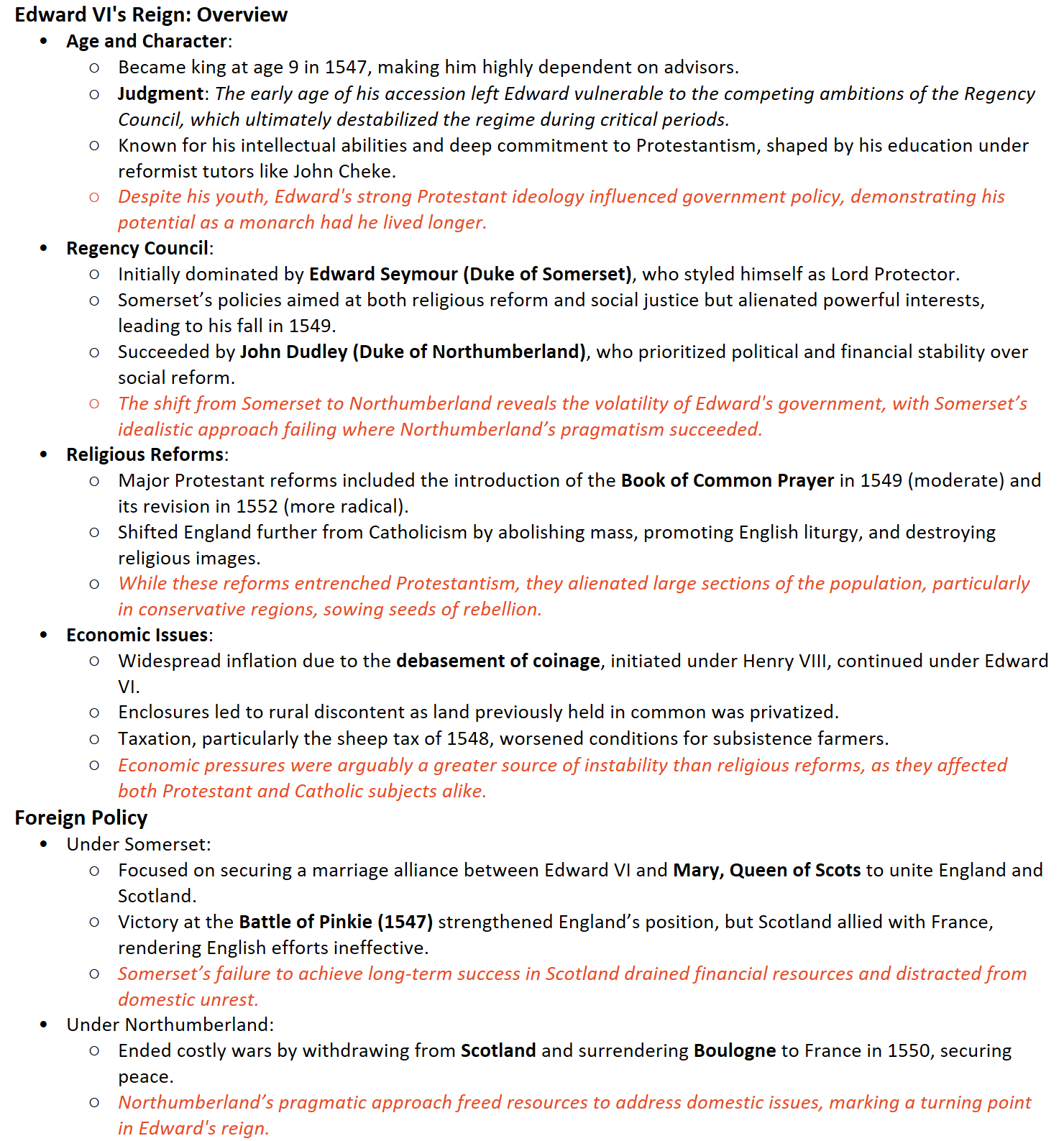
Western Rising 1549
The Main Causes of Rebellion and Disorder
Religious Changes:
The 1549 Book of Common Prayer, which replaced Latin services with English, was deeply unpopular in conservative regions like Devon and Cornwall.
Rebels demanded a return to traditional Catholic practices, including Latin services and the Mass.
The rebellion was primarily a religious protest, reflecting deep regional resistance to the centralizing reforms of Somerset’s government.
Economic Grievances:
The new sheep tax of 1548 disproportionately affected small-scale farmers in pastoral regions.
Enclosure of common lands exacerbated rural poverty and unemployment.
Economic grievances added to the rebellion’s intensity but were secondary to religious motivations.
The Frequency and Nature of Disturbances
Began in Devon and Cornwall in June 1549, initially as isolated protests before growing into an organized rebellion.
Rebels laid siege to Exeter, effectively paralyzing the region for several weeks.
The rebellion lacked significant noble leadership, relying instead on local priests and commoners.
The Western Rising was less coordinated than Kett’s Rebellion, limiting its threat to national stability but still exposing vulnerabilities in Somerset’s governance.
The Impact of the Disturbances Upon Tudor Governments
The rebellion stretched government resources as it coincided with Kett’s Rebellion in Norfolk.
Lord Russell, backed by mercenaries, defeated the rebels in August 1549 after prolonged fighting.
Reprisals were brutal, with executions of rebel leaders and widespread suppression of dissent.
The rebellion revealed the inadequacy of Somerset’s crisis management, contributing to his political downfall later that year.
The Maintenance of Political Stability
Somerset’s failure to address the underlying causes of rebellion—religious and economic grievances—led to widespread dissatisfaction.
His reliance on foreign mercenaries further alienated the populace.
Northumberland’s later policies focused on preventing similar uprisings by addressing economic issues and strengthening local governance.
While stability was eventually restored, the rebellion underscored the fragility of Edward’s government under Somerset.
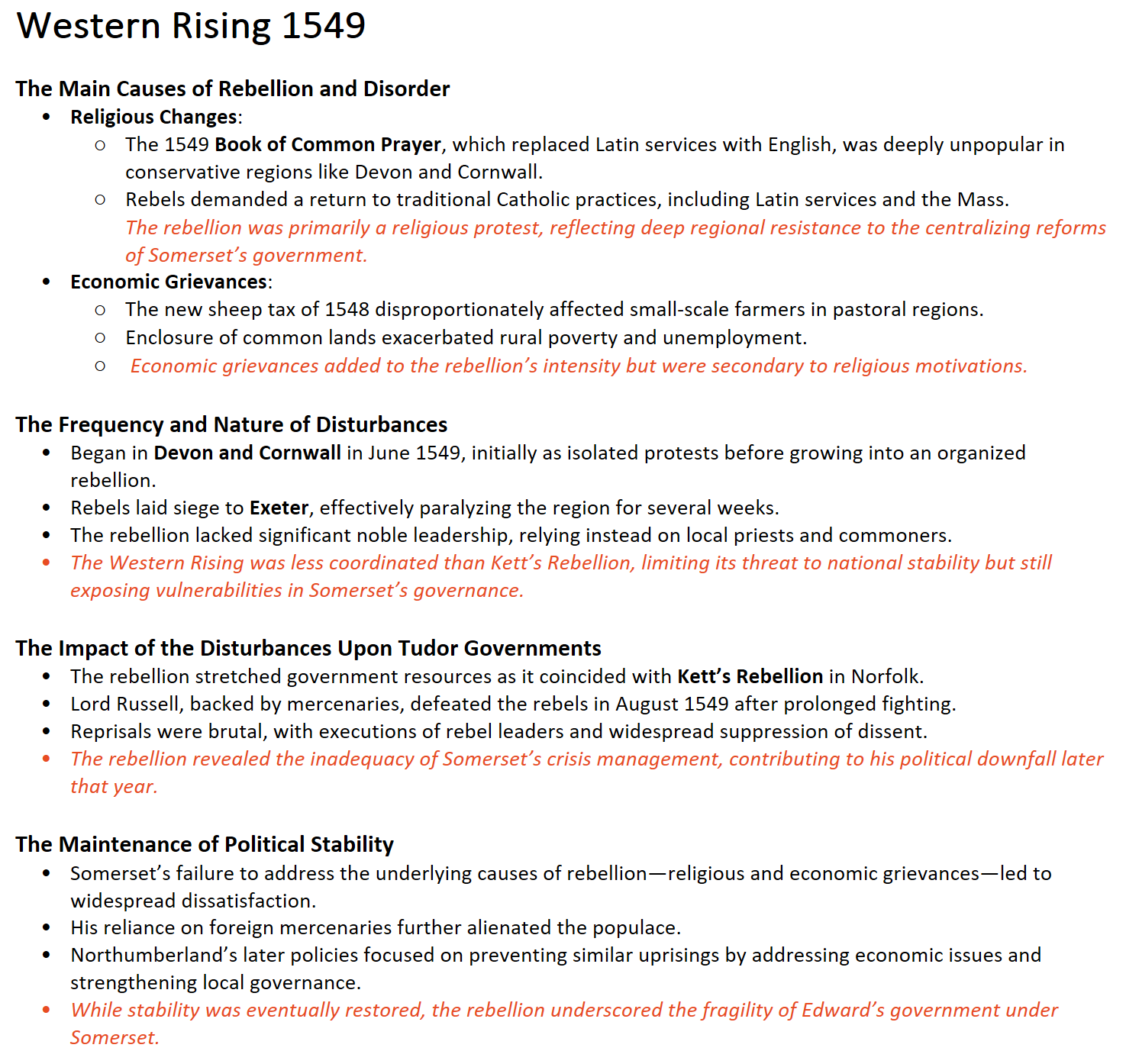
| |||||
| Kett's Rebellion 1549 | ||||
| |||||
| The Main Causes of Rebellion and Disorder
The Frequency and Nature of Disturbances
The Impact of the Disturbances Upon Tudor Governments
The Maintenance of Political Stability
Government Response
Somerset's Fall from Power
| ||||
| |||||
| Led by Rober Kett - Tanner (Leather working) and Landowner Manifesto - 29 Grievances Social-Economic Closure
Tone of Grievances We pray… We certify your grace…
Tradition Festival Day - Saint Thomas Becket's relics Wanted return to previous wells Camps - market centres Mousehold Heath Assembly point
Discipline and Order
Communication
Response of the authorities
The Kett's rebellion of 1549 was a large-scale social-economic rebellion, to assess how dangerous the rebellion was, the motives of the rebels, alongside their actions and the government response needs to be considered.
Overall, the Kett's rebellion was higher in threat to the government, than to the rebels. With the coinciding of the rebellion alongside other unrest of 1549, government resources were shared increasing the threat to the government but lowering the scale of dangerousness for the rebels than if the rebellion was stand alone. Ultimately, although 3,000 rebels were killed in August, this was after a long sustained rebellion that tarnished Somerset's reputation and allowed the rebels to receive promises of changes to enclosure and addressing grievances.
The government response to Kett's Rebellion was limited initially, as it coincided with various moments of unrest in 1549. For example, Northampton's attempt to squash the unrest failed, yet Warwick was able to defeat Norwich later in August of 1549 with a larger force. This shows that the initial attempts were limited in force and resources.
Context of 1549 Names and Dates Judgement
1549 reveals a great deal about the minority of Edward VI, but most importantly it reveals the building discontent surrounding England after the religious and economic changes across the Tudor era. The Western Rising was built off deep dissatisfaction with religious change that was also seen after the Reformation under Henry VIII and the split from traditional Catholicism. Whereas, Kett's Rebellion's grievances were in relation to the comparably worse economic conditions of 1549 then those under the prior Tudor monarchs. Both rebellions were focused on a response to unpopular policies, rather than an attempt to overthrow the government. | ||||
| |||||
| |||
| |||
| Northumberland's Coup (Warwick)
| ||
|  |
Northumberland's Coup (Warwick)
John Dudley - Earl of Warwick at the start of the reign of Edward VI
1551 - Makes himself Northumberland
Did not take the title of Protector as he didn't want to be associated with Somerset's regime
Delegated to able men to improve government efficiency
Improved the efficiency of the Privy Council by establishing a regime
Stopped debasement of the coinage
Improved royal finances by chasing owed feudal dues
Reduced food prices so as to alleviate social-economic tensions
1552 - passed a law that protected arable land and stemmed the tide of enclosure
No Social-economic uprisings despite harvest failures - 1550, 1551
1553
Edward was Ill.
Successor - Northumberland plotted to change the line of succession by persuading Edward to name Lady Jane Grey as heir.
Lady Jane Grey (9 Day Queen) + Northumberland's son Guilford Dudley
Grey's line claim through Henry VIII's sister
Edward VI dies 6th July 1553
Mary raised her standard at Framingham and won lots of support.
By the end of July, Northumberland was in the Tower and Mary entered London in triumph.
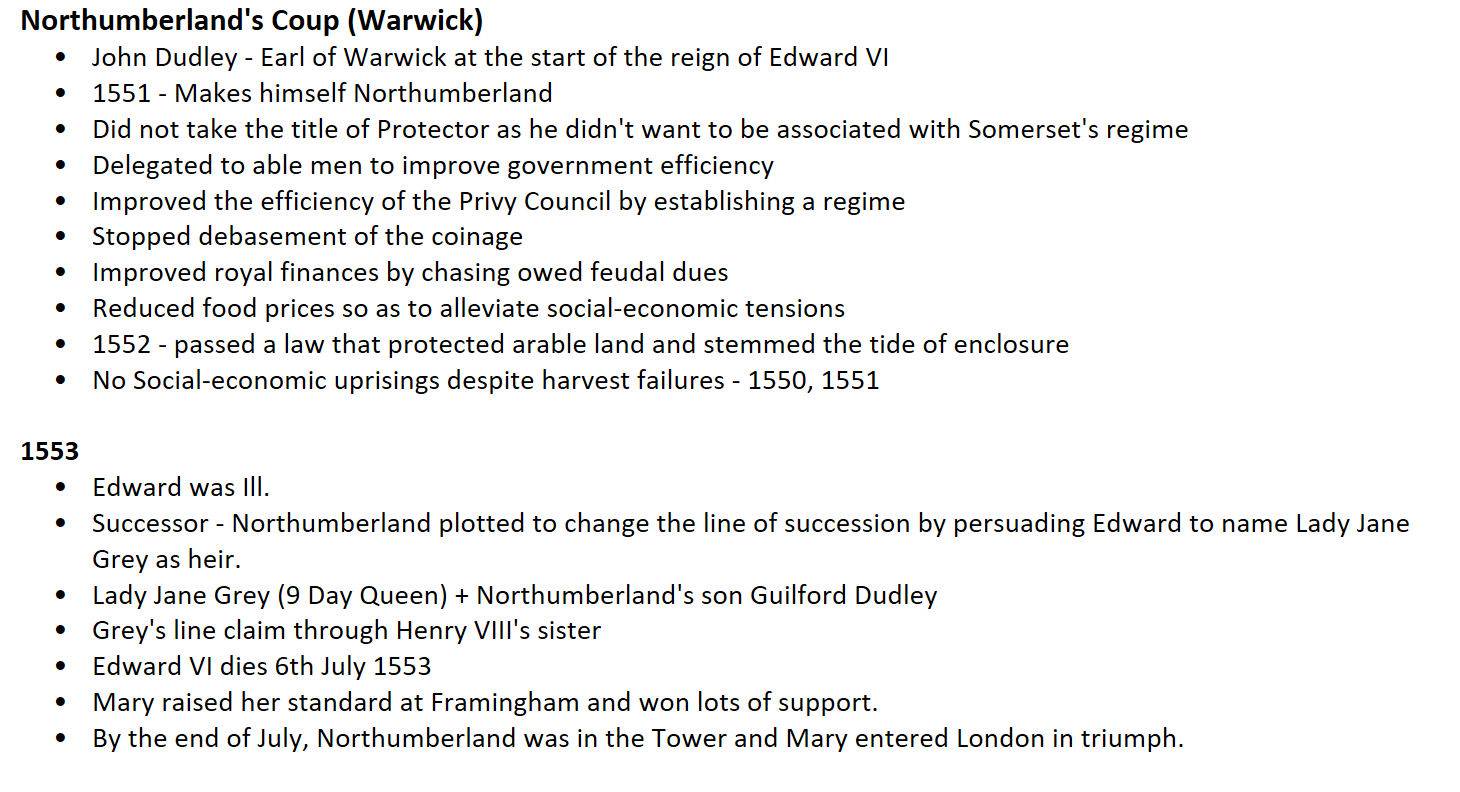
Somerset’s position as Lord Protector deteriorated rapidly due to his failures in governance, military campaigns, and political isolation.
Causes of Somerset’s Fall
Economic and Social Discontent:
Enclosure issues and the 1549 rebellions (e.g., Kett’s Rebellion) revealed widespread dissatisfaction with his policies.
Rising inflation and debasement of coinage exacerbated economic instability.
Foreign Policy Failures:
Military defeats in Scotland (end of the "Rough Wooing") weakened England's international standing.
Loss of Boulogne in 1550 further tarnished his reputation.
Political Isolation:
Alienated key nobles and Privy Council members due to his authoritarian style.
Failure to consult the Privy Council undermined his authority.
Arrest and Downfall:
October 1549: Somerset retreated to Hampton Court with Edward VI, later arrested by Northumberland's faction.
1550: Somerset formally removed from power and imprisoned.
Somerset’s failure was largely due to his inability to balance reformist ambitions with practical governance. His alienation of allies and mishandling of domestic crises reassured this.
Somerset’s fall was inevitable given his reliance on autocracy and inability to supress the ruling elites.
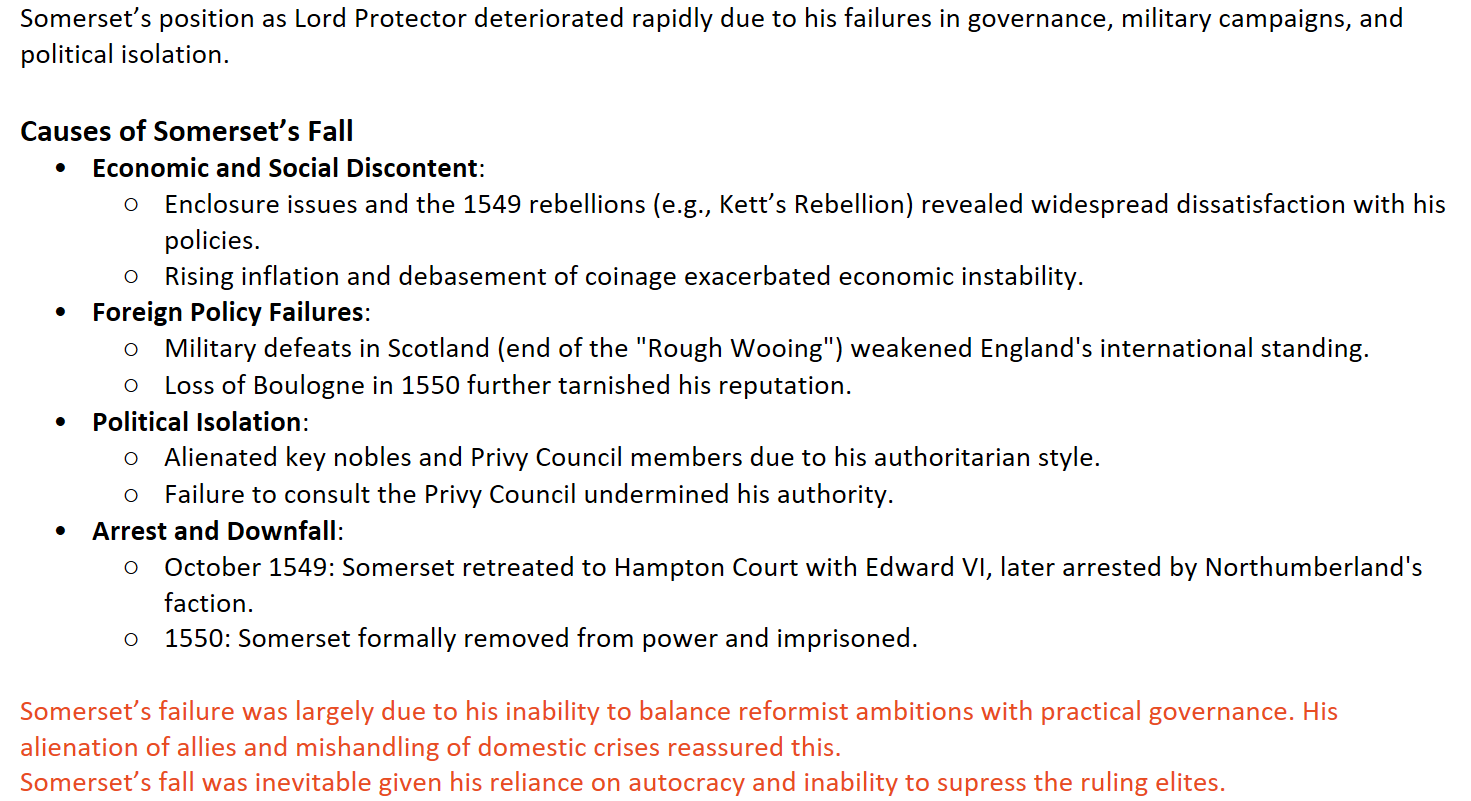
Northumberland’s Government (1550–1553)
After Somerset’s removal, John Dudley, Earl of Warwick (later Duke of Northumberland), established control and restructured the government.
Consolidation of Power
Privy Council Control:
Northumberland used the Council effectively to centralise power, relying on allies such as William Cecil.
Expelled opponents and promoted loyalists, avoiding Somerset’s mistakes of alienation.
Rehabilitation of the Economy:
Ended debasement of coinage and introduced financial reforms to stabilise currency.
Promoted trade and reduced the Crown’s debt.
Religious Policies:
Continued Protestant reforms: introduced the 1552 Book of Common Prayer, reinforcing a more radical Protestant doctrine.
Strengthened links with continental Protestantism, alienating conservative factions.
Foreign Policy
Restored peace with France (Treaty of Boulogne, 1550), which returned Boulogne to France for financial compensation.
Adopted a defensive posture to stabilise England’s fragile position.
Northumberland’s government was pragmatic, prioritising financial recovery and consolidation of power.
Northumberland’s leadership stabilised England after Somerset’s failures, though his religious radicalism risked division.
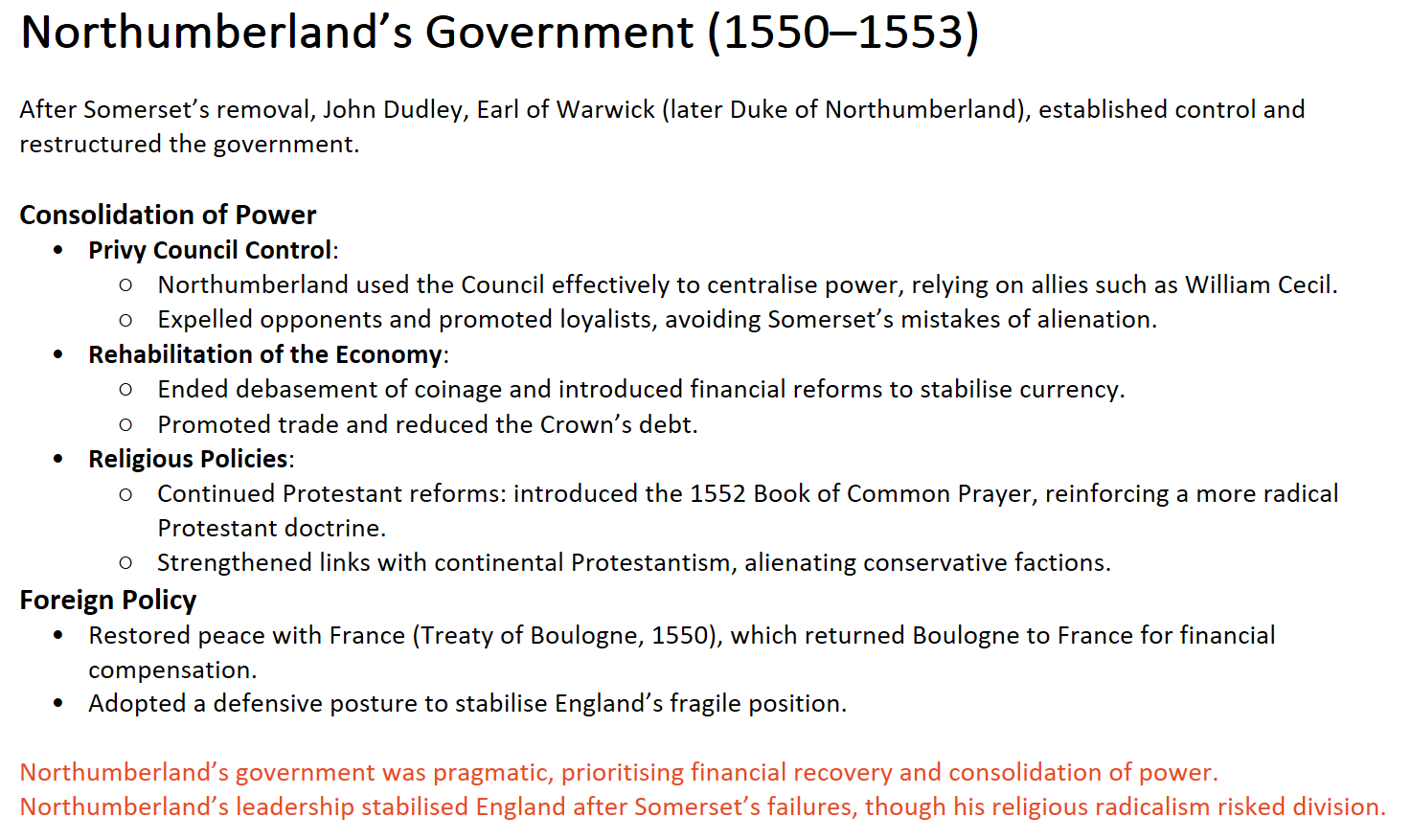
The Succession and ‘The Device’ (1553)
The succession crisis was sparked by Edward VI’s failing health and Northumberland’s attempts to retain power by altering the line of succession.
Edward VI’s Illness and Northumberland’s Ambitions
Edward’s declining health (likely tuberculosis) by 1552 created uncertainty over succession.
The 1544 Succession Act and Henry VIII’s will favoured Mary Tudor, but her Catholicism posed a threat to Northumberland and Protestant reform.
The Device for the Succession (1553)
Edward drafted the ‘Device’ to exclude Mary and Elizabeth, favouring Lady Jane Grey, Northumberland’s daughter-in-law and a Protestant.
Declared Lady Jane Grey as Edward’s successor, legitimising the Protestant line.
The Coup and Lady Jane Grey’s Reign
July 1553: Edward died, and Lady Jane Grey was proclaimed queen.
Mary Tudor quickly raised an army, gaining popular support due to her legitimacy under Henry VIII’s will.
Northumberland’s coup failed within weeks. Mary’s forces arrested Northumberland, and Lady Jane Grey was deposed after just nine days.
The ‘Device’ was a desperate gamble to secure Protestantism and Northumberland’s power. However, it lacked popular and political support.
The succession crisis exposed the fragility of Edwardian reforms and Northumberland’s overreach, paving the way for Mary’s Catholic restoration.
Lady Jane Grey’s Legacy
Lady Jane Grey’s nine-day reign is symbolic of the instability of Edward VI’s later years. Her brief tenure highlighted:
The lack of political legitimacy behind Northumberland’s plans.
The enduring strength of Tudor dynastic loyalty among the nobility and populace.
Lady Jane Grey’s tragic fate highlighted the failure of Edward VI’s Protestant succession and the enduring loyalty to Henry VIII’s dynastic legacy.
